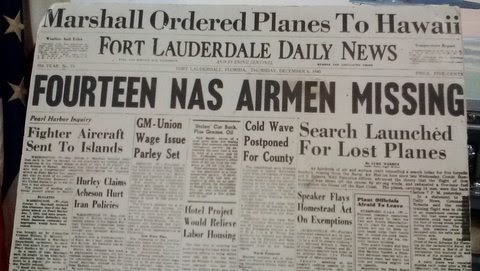 |
| Plans drawn for development - 1940 Courtesy of Debbie Gould Tucker |
By Jane Feehan
Edgar Davis Gould’s purchase of a swampy, mangrove-covered island
off Las Olas Boulevard in March 1940 was reported as the largest single
transaction in that area since the boom days of the 1920s. Created in 1925 with
soil dredged from New River, the property had been held by Mr. and Ms. W.L.
Mensendieck since 1935. The sales price was not revealed in news accounts.
Work began within 10 days after the contract was signed with
installation of a water main by the city of Fort Lauderdale and immediate
landscaping with royal palms. Gould planned 50 lots. He worked with other
property owners and the city to widen and beautify the bridge to the area off
23rd Avenue (an area now known as Seven Isles but at one time
Lauderdale Isles). Fort Lauderdale News claimed, “development of Gould
Island writes a new page in history of Fort Lauderdale’s growth.”
Gould also may have written a new page in sales history.
In May of 1941, the Fort Lauderdale News reported he
had sold eight more lots than any agent selling off Las Olas. Gould had set a record:
he sold 10 lots in 10 days. He made big waves after arriving in 1940, just months
before the “island” purchase and launch of its development. Lots generally went
for $4,000. Larger, waterfront lots sold for $17,500 in 1944. The island was
completely developed by 1945.* A recent (2023) search of real estate listings there featured a house for sale for more than $31 million.
Some said Gould’s immediate sales success was a credit to
his planning skills. Others would say his law degree from Harvard University in
1900 set his course. Though he practiced law in Boston, his birthplace, he
changed careers after five years. He stepped into advertising in New York City and then
served as manager and director of the Regal Shoe Company.
Granddaughter Debbie Gould Tucker, today a St. Augustine
resident along with husband Bill Tucker, says the family isn’t quite sure why
he left New Rochelle, New York but it may have been because his son (Debbie’s
father) and namesake Edgar D. Gould II or “Bill” as he was called, was serving
in the U.S. Navy in Fort Lauderdale where he also made his home.
The senior Gould’s move to Fort Lauderdale was a good one at the right time. His sales record, the newspaper reported, “establishes him as number one representative of the spirit, tempo and enterprise which has kept Fort Lauderdale in the van [guard] of the nation’s fastest-growing cities for the last decade.”
 |
| Gould Castle and widened bridge circa 1940 Courtesy of Debbie Gould Tucker |
He built one of the first homes on Gould Island in 1941 on
Del Mar Drive. The architect was Carlos B. Schoeppl and the builder was Richardson
Construction, Debbie’s uncle. He landscaped the home with a circular tower (thus
its name, Gould’s Castle) with a Victory V and with two royal palms on either
side as “sentinels” (see photo). It was dressed up with planted “Legion of Honor
marigolds,” a fitting acknowledgment of World War II efforts.
Advertisements for the island highlighted 97.5-foot frontage
on lots that were already graded to street level in a community just two or
three minutes to the beach and three or four minutes “to town.” One ad closed
with encouragement to “call your broker or Mr. Gould at his home at 1621.”
Gould’s real estate endeavors included the purchase of Donaldson Apartments from the Donaldson estate in 1943 for $45,000. It was the largest real estate transaction of the week prior to Dec. 11.
The building featured 10 large apartments and a
penthouse (it remains today as a renamed boutique hotel behind the Sheraton at
300 N. Birch Rd.). This is what Debbie Gould Tucker remembers fondly of grandfather’s
Fort Lauderdale legacy.
“We spent summer days there, just off the beach, with a
clear view of the Intracoastal,” Debbie recollects. “During the winter, visitors—family
friends—came from New Rochelle for three months. My grandmother Lalia, Edgar’s
wife, lived there with her sister after he died.”
Gould died Jan. 28, 1945, at age 70 just a few years after
moving to Fort Lauderdale. He left a big legacy in a short time including his son,
Bill, who went into local yacht sales, granddaughter Debbie, and her three
siblings, Patty, Billy and Eddie, all born in Fort Lauderdale. They are also
related to the Slayton family (auto sales). Bill Gould’s children grew up near
the Las Olas Isles, but Debbie often drove—well, nearly flew—over today's seven
bridges connecting the streets of Gould Island for fun (as a few of us did as
highschoolers). Her husband, Bill
Tucker, is related to Verne Tucker who contributed a column in the Fort
Lauderdale News, Sun Strokes, a chuckle maker.
A chat with most anyone born in Fort Lauderdale during the 1940s or 50s tends to weave a map of family connections with contributions to our history.
This, the way we used to be ….
*Today, Seven Isles is home to about 1,100 residents in 315 households
on nine streets:
Aqua Vista Boulevard
Barcelona Drive
Castilla Isle
Del Mar Place
De Sota Drive
De Sota Terrace
Pelican Isle
Sea Island Drive
Seven Isles Drive
Sources:
Fort Lauderdale News, March 1, 1940
Fort Lauderdale News, March 18, 1940
Fort Lauderdale News, May 7, 1940
Fort Lauderdale News, Sept. 6, 1940
Fort Lauderdale News, March 9, 1941
Fort Lauderdale News, April 27, 1941
Fort Lauderdale News, May 25, 1941
Fort Lauderdale News, Sept. 14, 1941
Fort Lauderdale News, Aug. 4, 1941
Fort Lauderdale News, Nov. 2, 1941
Fort Lauderdale News, Aug. 25, 1943
Fort Lauderdale News, Dec. 11, 1943
Fort Lauderdale News, Feb. 2, 1944
Fort Lauderdale News, Jan. 29, 1945
Tags: Fort Lauderdale history, history of Fort Lauderdale, Seven Isles, Fort Lauderdale communities, Edgar D. Gould, Debbie Gould Tucker





























